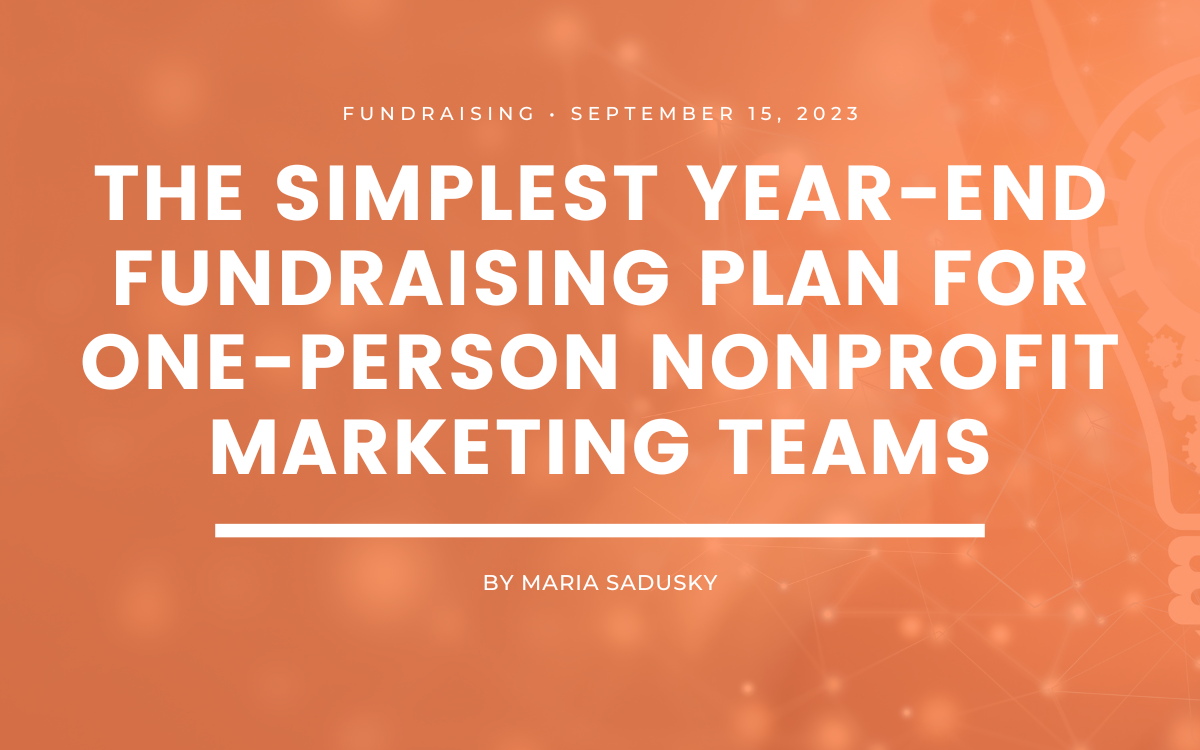The Simplest Year-End Fundraising Plan for One-Person Nonprofit Marketing Teams
9 min to read ✭
Fundraising is a vital component of any nonprofit organization’s operations, and the year-end presents a crucial opportunity to maximize donations. This post offers an optimized playbook for small nonprofit marketing teams to navigate this essential period. By the end of this, you should have. asolid year-end fundraising plan that you can start utilizing immediately.
The 5 W’s of Year-End Fundraising
WHY: Defining your year-end fundraising goal
It’s time to craft a compelling and clear goal. If your goal is to raise more money this year-end, then it is a good time to break that goal down.
To have a successful year-end fundraising campaign, start by setting a SMART objective. Craft a specific, measurable, attainable, relevant, and time-bound goal. Instead of a vague aim, target a specific amount, like $100,000. Strive for a 20 to 50% increase from last year’s fundraising. Make sure your goal aligns with your aim of raising more money this year. Set December 31st as your deadline. Having a SMART target sets the stage for your fundraising efforts. You can now maximize donations during this crucial period with our playbook for nonprofit marketing teams.
Here is a diagram to break this goal down using smart rules.
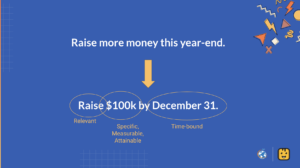
WHO: Who, specifically, are you trying to reach in your year-end fundraising plan?
You might be wondering how to create a crystal clear supporter persona. Well, wonder no further. Try breaking your audience up into 3 personas.
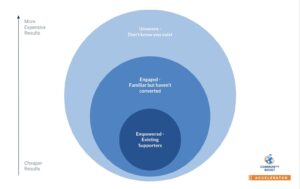
Our audiences can be broadly categorized into three groups – existing supporters, engaged audiences, and unaware audiences. We can then map these audiences to our selected channels for a comprehensive year-end fundraising plan.
WHAT: What does your supporter get out of donating to you?
Alright, so it’s important to highlight the reasons why someone should donate to your organization.
This framework, which we delve deeper into in our accelerator program, serves as a guide to understanding why someone might donate to us and what they stand to gain from their donation. At its most basic, the Nonprofit Value Equation comprises Four Elements:
- Dream Outcome: The ideal result a donor hopes to achieve.
- Perceived Likelihood: The donor’s perception of how likely they are to attain the dream outcome.
- Divided by: This indicates that the following factors could reduce the perceived value.
- Effort, Sacrifice, and Friction: What a donor must give up or overcome to achieve the dream outcome.
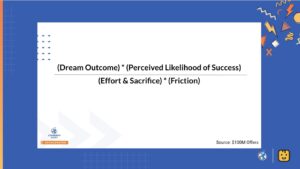
The Cancer Research Institute, one of our esteemed community members, is dedicated to creating a world empowered by immune enhancers. Their mission is bolstered by well-documented impact stats, which lends credence to their cause. Furthermore, their long-standing presence in the field further enhances their credibility.
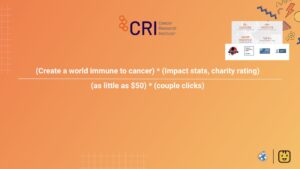
WHERE: Where are you going to reach your supporters?
Your 3-Channel Mix
To maximize your year-end fundraising efforts, it’s crucial to implement a multi-channel strategy that targets different segments of your audience. The four fundamental channels we recommend are Facebook and Instagram ads, Email marketing, SMS, and Organic Social. Mastering these basics can drive significant results. However, if you’re already utilizing these channels effectively, we could explore more advanced strategies tailored specifically for your campaign.
Let’s break down how each channel fits into our strategy. Our audiences can be broadly categorized into three groups – existing supporters, engaged audiences, and unaware audiences. We can then map these audiences to our selected channels for a comprehensive year-end fundraising plan.
Existing Supporters:
These are high-value individuals who have donated in the past. They should be reached via Email, SMS, and Direct Mail. Emphasize the value equation in your email and SMS messages to motivate them to donate. In addition, use Facebook and Instagram ads targeting those who did not open your emails. Direct mail is also an effective method if you have the budget for it. If the budget isn’t enough to cover both social media ads and direct mail, prioritize social media ads due to their targeted nature and ROI potential.
Need help with your Meta Advertising? Our team is driven to support your year-end fundraising plan. They’d love to chat!
Engaged Audiences:
These are the individuals who engage with your content but haven’t donated yet. Use email and SMS tailored to stress the potential success and dream outcomes. Meta and TikTok ads can also be used to nudge these engaged audiences to convert.
Unaware Audiences:
For those who have not yet heard of your organization, Facebook and Instagram ads are the preferred channels. They allow you to hyper-target new audiences based on their interests. Although organic reach is possible, it tends to be minimal, so paid advertising is more effective.
Consider leveraging the Google Ad Grant, a powerful tool to drive awareness and engagement throughout the year. However, due to bid caps, it might not be as effective for end-of-year fundraising as other channels. We recommend focusing on the channels that provide the highest leverage for your specific campaign, typically Facebook and Instagram ads, Email or SMS, and Direct Mail. If you need help with the Google Ad Grant or any other aspect of your strategy, don’t hesitate to reach out to us. We’re here to help you scale your impact and revenue.
WHEN: R.A.I.S.E Campaign Timeline
To make your year-end fundraising plan a success, it’s crucial to involve your key supporters and incorporate their feedback throughout the campaign process. Mark Hackett, a member of our Community Accelerator, provides an excellent example with his innovative approach to campaign planning.
Mark has a dedicated core group of supporters who he engages with for feedback on key aspects of the campaign, from messaging frameworks to website changes. This approach allows for a ‘soft launch’, serving two essential purposes:
- Valuable Feedback: Your core supporters are invested in the success of your organization and will provide constructive feedback on your initiative. Leveraging their insights allows you to refine your campaign based on their recommendations, thereby increasing its effectiveness.
- Early Donations: When you involve your supporters in the planning stage, they are more likely to donate as soon as the campaign commences. This sets the stage for campaign momentum, and provides an encouraging start indicating the campaign’s potential success.
In many cases, these core supporters not only provide feedback but offer to assist in other areas such as marketing, email communication, or running social media campaigns. By incorporating this feedback-based, community-centric approach, you can drive a successful fundraising campaign.
As part of your overall campaign strategy, you should also include a comprehensive timeline marking out key dates and milestones, while considering feedback from your core supporters. By customizing our frameworks such as the ‘Raise Your Hand’, ‘RACE’, ‘Reciprocity’, and ’10th Planet Stewardship’ with your own specifics, you can create a robust timeline for the whole year.
Here’s a quick wrap up of everything we talked about today!
Step 1: Set Your Year-End Fundraising Goal
Start by identifying your fundraising goal. Make it SMART – Specific, Measurable, Attainable, Relevant, and Time-bound. Determine both the total amount you aim to raise and the targeted audience for your campaign. Consider the impact you wish to make and align it with your organization’s mission.
Step 2: Identify Your Target Audience
Define the specific audience you want to reach. Create a persona by considering demographics such as age, gender, location, and interests. Delve deeper into understanding their motivations, values, and potential obstacles they may face when donating. This will enable you to tailor your messaging to their needs and desires.
Step 3: Craft a Compelling Value Proposition
Highlight the reasons why someone should donate to your organization. Clearly communicate the impact of their contribution and align it with their values and aspirations. Inspire potential donors by effectively conveying the value they can create through their support.
Step 4: Streamline the Donation Process
Ensure a seamless and user-friendly donation process. Optimize your website or donation platform to provide a simple experience. Express heartfelt gratitude to all donors, regardless of the amount contributed, to foster long-term relationships.
Step 5: Choose Optimal Channels
Select the channels that best align with your target audience’s preferences and behaviors. Leverage social media platforms, email marketing, direct mail, or a combination thereof. Each channel has unique strengths and can serve different purposes in your campaign strategy.
Step 6: Develop a Timeline and Engage
Create a comprehensive timeline for your fundraising campaign. Define start and end dates, and include key milestones, content creation, outreach efforts, and donor engagement activities. Monitor progress against your timeline and make necessary adjustments along the way.
Remember, customization is crucial to design effective fundraising strategies that resonate with your target audience and maximize your year-end fundraising efforts. Adapt this plan to fit your organization’s specific needs and circumstances.
Frequently Asked Questions on Year-End Fundraising Plans
Q1: How long is too long to run a year-end campaign?
A1: There isn’t a hard and fast rule for this. It’s more about monitoring your audience’s response to determine if they’re becoming fatigued with your messaging. A high frequency of the same ads or negative feedback and unsubscribes from emails can be indicators that your campaign is running too long.
Q2: What are some strategies for avoiding donor fatigue?
A2: It’s important to communicate differently to different segments of your audience. For instance, those who have already donated should not continue receiving appeal emails as it can lead to fatigue. Additionally, make sure you’re reaching out to new potential donors and not just the “usual suspects.”
Q3: How do you effectively manage advertising for a major fundraising event and year-end giving appeals simultaneously?
A3: Consider the event or gala as another channel for fundraising and segment the audiences accordingly. Each segment should receive different messaging. Once someone commits to attending an event, they should no longer receive the same year-end fundraising emails.
Q4: Are SMS and direct mail considered the same channel?
A4: No, SMS and direct mail are different channels. Direct mail is typically used to reach existing supporters while SMS can be used to engage and convert both engaged and existing supporters. Both have their own strengths and should be used strategically based on your campaign needs.


